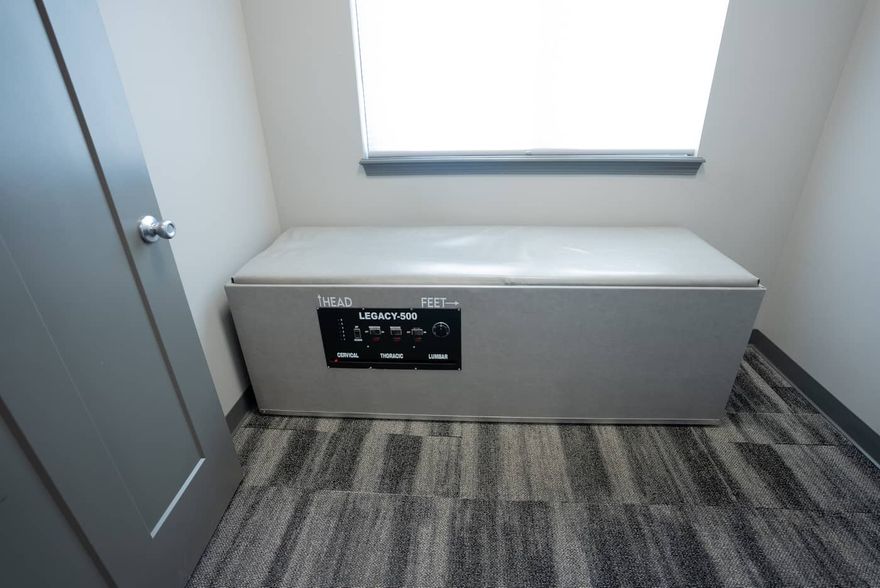Chiropractic Services Performed at Our Office
Chiropractic Adjustments
The primary method of care performed at Cedar Rapids Chiropractic clinic is known as a “chiropractic adjustment.” The purpose of the chiropractic adjustment is to restore joint mobility by manually applying a controlled force into joints that have become hypomobile—or restricted in their movement—as a result of a tissue injury. Tissue injury can be caused by a single traumatic event, such as improper lifting of a heavy object, or through repetitive stresses, such as sitting in an awkward position with poor spinal posture for an extended period of time. In either case, injured tissues undergo physical and chemical changes that can cause inflammation, pain, and diminished function for the sufferer. Adjustment of the affected joint and tissues, restores mobility, thereby alleviating pain and muscle tightness, and allowing tissues to heal.
Digital X-Ray
Dr. Jenkins utilizes visual inspection of the spine through X-Ray analysis in order to aid in the diagnosis process and rule out contraindications to treatment. Digital X-Ray is far superior over film images. There is greater detail and also the ability to edit and manipulate the image to see questionable areas. Having digital X-ray also allows us to give patients copies of their images to share with other medical providers. We also have the ability to send these directly to outside radiologists for over read services.
Extremity Adjustments
Extremity adjustments or extremity manipulations are adjustments made to joints beyond the spine. These joints include your wrists, shoulders, elbows, knees, ankles, fingers and toes. Just like with your spinal joints, these joints can become irritated and cause pain and other symptoms. Your extremities rely on proper motion and positioning to work optimally, so they can benefit from regular adjustment just like your spine. By adjusting both the spine and the extremities, we can decrease joint pain, improve flexibility and increase range of motion. Chances are, if you are having problem with a joint, a chiropractic adjustment may be able to help.
Intersegmental Traction
This is a therapy we perform after the adjustment called Intersegmental Traction. It separates the vertebrae to allow blood flow to the discs, exercises muscles and ligaments, and stimulates important acupuncture points. This is especially beneficial for lower back conditions such as slipped discs, as well as mid and upper back pain.
Needle-Less Acupuncture
Auricular acupuncture is the stimulation of acupuncture points on the external ear surface that correspond to areas or functions of the body. All signals induced by ear acupuncture travel through a specific part of the brain to the corresponding body parts. Dr. Jenkins utilizes non-invasive electro acupuncture, meaning NO NEEDLES and an adjustable "current" that helps reduce symptoms and speed up the healing process.
Diversified Technique
The Diversified technique is the most widely used chiropractic technique used in the United States. It is currently taught in every chiropractic school, and is reported to be used in over 90% of chiropractic offices. Therefore, this is the one most people think of when they hear the word chiropractor. The Diversified adjustment uses a high-velocity, low-amplitude thrust that usually results in the cavitation of a joint (a quick shallow thrust that cause a popping noise). It has been proven both safe and effective in treating numerous musculoskeletal conditions. The Diversified technique appears very similar to the Gonstead adjusting technique, but there are some subtle differences. The Gonstead technique also uses a HVLA that typically results in a popping noise. One key difference between the two is the neck or cervical adjustment is done with patient lying down with Diversified, as opposed to sitting in a chair for a Gonstead adjustment. We've found most people can relax their neck muscles more lying down than sitting up, so we prefer to use Diversified in our office. The spinal analysis is also different for the technique, although both utilize X-ray analysis in determining subluxations or misalignments of the spine. Both produce great results and are used highly in Iowa.
Specific Prone
Specific prone is a manual adjusting technique that does not involve rotation of the spine when adjusting the neck or low back. It allows us to treat any patient, of any age, with any pre existing conditions. The cervical (neck) adjustment carries absolutely no risk of causing a VBI or stroke, even in those who have had one prior. The low back or lumbar specific prone adjustment also does not involve rotation, making it perfect to use in cases where a spinal disc issue is suspected or has been confirmed. The traditional side posture maneuver can actually make disc problems worse. We are grateful to be able to offer this safe, gentle, and effective spinal technique with our patients.


